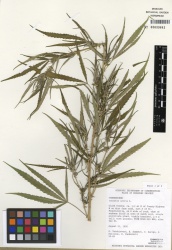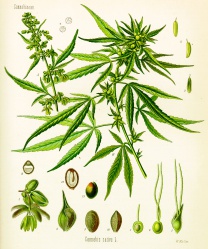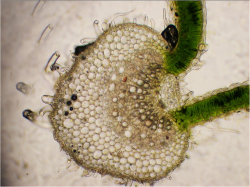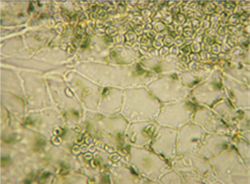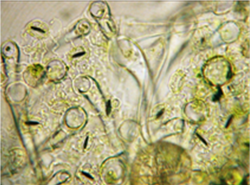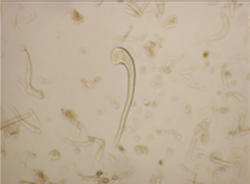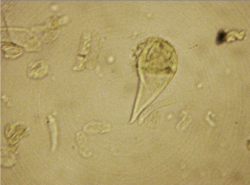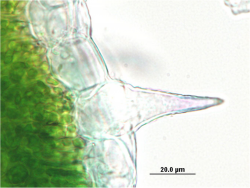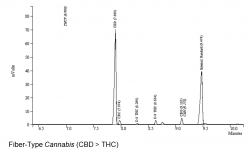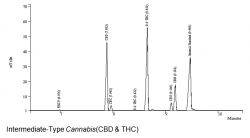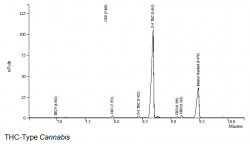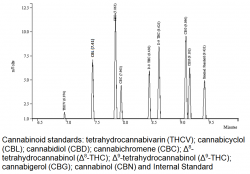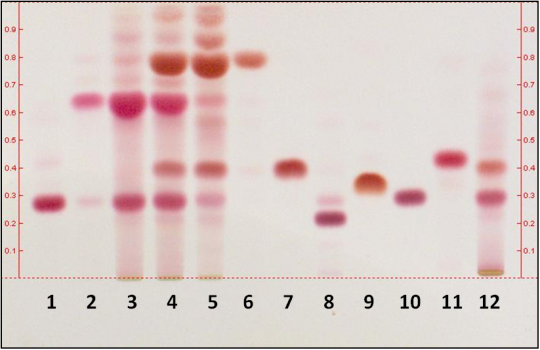Cannabis spp. (pistillate inflorescence and leaf)
(add entry structure) |
(add micro images) |
||
| (9 intermediate revisions by one user not shown) | |||
| Line 6: | Line 6: | ||
=Botanical Voucher Specimen= | =Botanical Voucher Specimen= | ||
| − | + | {{Media | cat=Voucher | |
| + | |||
| + | | source=MOBOT, Tropicos.org | ||
| + | | mainimage=Cannabis sativa Tropicos 100003863.jpg | ||
| + | | companyimage=TropicosLogo.gif | ||
| + | | companyURL=http://www.tropicos.org/Image/100003863 | ||
| + | | reference=Tropicos.org. Missouri Botanical Garden. 09 October 2014 http://www.tropicos.org/Image/100003863}} | ||
=Organoleptic Characteristics= | =Organoleptic Characteristics= | ||
| − | + | {| border=1 | |
| + | | | ||
| + | {{Macroscopy| source=American Herbal Products Association. March 2013. Organoleptic Analysis of Herbal Ingredients. AHPA: Silver Spring, MD | ||
| + | |companyimage=14 0924 AHPA logo High Res.jpg | ||
| + | | companyURL=http://www.ahpa.org/default.aspx?tabid=419 | ||
| + | |description= | ||
| + | | scent=Narcotic type (heavy,nauseating, and suffocating;increased by moisture)}} | ||
| + | |} | ||
=Macroscopic Characteristics= | =Macroscopic Characteristics= | ||
| + | {| border=1 | ||
| + | | | ||
| + | {{Macroscopy| source=Recommended methods for the identification and analysis of cannabis and cannabis products, United Nations Office on Drugs and Crime, Vienna, 2009. (ST/NAR/40) | ||
| + | |companyimage=UNODC Logo.png | ||
| + | | companyURL=http://www.unodc.org/documents/scientific/ST-NAR-40-Ebook.pdf | ||
| + | |description=“…Cannabis is an annual, dioecious (the flowers on individual plants are unisexual), flowering herb. Staminate (male) plants are usually taller but less robust than pistillate (female) plants.” | ||
| + | “…Stem is green, erect, hollow and longitudinally grooved. It can vary from 0.2-6 m, although most of the plants reach heights of 1-3 m. The extent of branching, like plant height, depends on environmental and hereditary factors as well as the method of cultivation. The side branches vary from opposite to alternate at any part of the main stem. The leaf arrangement changes from decussate (oppositely arranged) to alternate on the extremities of the plant. Leaf stalks (petioles) are 2-7 cm long with a narrow groove along the upper side. The leaf is palmate and consists of 3-9 linear-lanceolate leaflet blades of 3-15 x 0.2-1.7 cm. The margins are coarsely serrated, the teeth pointing towards the tips; the veins run out obliquely from the midrib to the tips of the teeth. The lower (abaxial) surfaces are pale green with scattered, white to yellowish brown, resinous glands.” | ||
| + | |||
| + | “…The pistillate (female) flowers are more or less sessile and are borne in pairs. Each flower has a small green bract enclosing the ovary with two long, slender stigmas projecting well above the bract.”}} | ||
| + | |||
| + | {{Media |cat=Macroscopy | ||
| + | | source=Köhler, Medizinal-Pflanzen in naturgetreuen Abbildungen und kurzerläuterndemTexte (1887) | ||
| + | | mainimage=Cannabis sativa - Köhler.jpg | ||
| + | | reference=Köhler, Medizinal-Pflanzen in naturgetreuen Abbildungen und kurzerläuterndemTexte (1887)}} | ||
| + | |||
| + | |} | ||
=Microscopic Characteristics= | =Microscopic Characteristics= | ||
| + | {| border=1 | ||
| + | | | ||
| + | {{Microscopy| source=Recommended methods for the identification and analysis of cannabis and cannabis products, United Nations Office on Drugs and Crime, Vienna, 2009. (ST/NAR/40) | ||
| + | |companyimage=UNODC Logo.png | ||
| + | | companyURL=http://www.unodc.org/documents/scientific/ST-NAR-40-Ebook.pdf | ||
| + | |description=“… Cannabis sativa can be identified by microscopic structures on the surface of the plant, namely, by trichomes. Two types of trichomes occur and can be observed with a binocular microscope with a magnification factor of 40: | ||
| + | (a) Non-glandular trichomes are numerous, unicellular, rigid and curved hairs, with a slender pointed apex: | ||
| + | - Cystolithic trichomes found on the upper surface of the cannabis leaves have a characteristic bear claw shape and may have calcium carbonate crystals (cystoliths) visible at their bases. Frequently, the trichome is broken and the cystolith freed; | ||
| + | - Non-cystolithic trichomes occur mainly on the lower side of the leaves, bracts and bracteoles and lack the enlarged base; | ||
| + | - The simultaneous presence of these bear claw-shaped trichomes on the upper surface and the fine, slender non-cystolithic trichomes on the lower surface of the leaves is a characteristic of cannabis. | ||
| + | |||
| + | (b) Glandular trichomes. They occur as: | ||
| + | - Sessile glands, i.e. trichomes without stalk, which are generally found on the lower epidermis; | ||
| + | - Small bulbous glandular trichomes with one-celled stalks; | ||
| + | - Long multicellular stalks on the bracteoles surrounding the female flowers (multicellular stalked glandular trichomes). | ||
| + | |||
| + | These are mainly associated with the flower structures (pistillate plants being particularly rich in these structures) but they can also be found on the underside of the leaves and occasionally on the stems of young plants. | ||
| + | Some plants possess trichomes that may be confused with those present on Cannabis sativa and care should be taken in definitive identification. However, the combination of cystolithic hairs on the leaf upper surface and longer trichomes and sessile glands on the lower surface, which is unique to Cannabis sativa, enables positive identification of even fragmented material.”}} | ||
| + | |||
| + | {{Media3 |cat=GC | ||
| + | |companyimage= OleMiss Logo.png | ||
| + | |companyimage2= OleMiss Logo.png | ||
| + | |companyimage3= OleMiss Logo.png | ||
| + | |source=National Center for Natural Products Research, School of Pharmacy, | ||
| + | University of Mississippi, University, MS 38677, USA | ||
| + | |source2=National Center for Natural Products Research, School of Pharmacy, | ||
| + | University of Mississippi, University, MS 38677, USA | ||
| + | |source3=National Center for Natural Products Research, School of Pharmacy, | ||
| + | University of Mississippi, University, MS 38677, USA | ||
| + | |mainimage=Cannabis sativa - OleMiss - Transverse section leaflet.png | ||
| + | |caption1=Transverse section in the midrib of the leaflet | ||
| + | |image2=Cannabis sativa - OleMiss - Upper epidermis leaflet.png | ||
| + | |caption2=Upper epidermis of the leaflet | ||
| + | |image3=Cannabis sativa - OleMiss - Lower epidermis leaflet.png | ||
| + | |caption3=Lower epidermis of the leaflet}} | ||
| + | |||
| + | {{Media3 |cat=GC | ||
| + | |companyimage= OleMiss Logo.png | ||
| + | |companyimage2= OleMiss Logo.png | ||
| + | |companyimage3= OleMiss Logo.png | ||
| + | |source=National Center for Natural Products Research, School of Pharmacy, | ||
| + | University of Mississippi, University, MS 38677, USA | ||
| + | |source2=National Center for Natural Products Research, School of Pharmacy, | ||
| + | University of Mississippi, University, MS 38677, USA | ||
| + | |source3=National Center for Natural Products Research, School of Pharmacy, | ||
| + | University of Mississippi, University, MS 38677, USA | ||
| + | |mainimage=Cannabis sativa - OleMiss - Non-glandular trichrome.png | ||
| + | |caption1=Non-glandular trichrome | ||
| + | |image2=Cannabis sativa - OleMiss - Cystolithic trichrome.png | ||
| + | |caption2=Cystolithic trichrome | ||
| + | |image3=Cannabis sativa - OleMiss - Epidermal cells with cystolithic trichome.png | ||
| + | |caption3=Epidermal cells with cystolithic trichrome}} | ||
| + | |||
| + | |} | ||
| + | |||
| + | =Gas Chromatography Identification= | ||
| + | |||
| + | |||
| + | {| border=1 | ||
| + | | | ||
| + | {{Macroscopy | ||
| + | | companyimage=OleMiss Logo.png | ||
| + | | companyURL=http://pharmacy.olemiss.edu/ncnpr/ | ||
| + | | source=National Center for Natural Products Research, School of Pharmacy, University of Mississippi, University, MS 38677, USA | ||
| + | | description='''''Cannabis'' spp.''' | ||
| + | |||
| + | '''Internal Standard Solution:''' 1 mg/mL 4-androstene-3,17-dione in a mixture of chloroform and methanol (1:9). | ||
| + | |||
| + | '''Test Sample Preparation:''' 100 mg ground plant material in 3 mL of Internal Standard Solution, macerate at room temperature for 1 h,sonicate for 5 min, filter, and use the filtrate. | ||
| + | |||
| + | '''Column:''' 15-m x 0.25-mm, 0.25-um film, J&W Scientific DB-1 | ||
| + | |||
| + | '''Oven Program:''' 170°C for 1 min, increase to 250°C at 10°C/min, hold at 250° for 3 min. | ||
| + | |||
| + | '''Injection Port:''' 240°C | ||
| + | |||
| + | '''Detector:''' FID, 260°C | ||
| + | |||
| + | '''Carrier Gas:''' Helium | ||
| + | |||
| + | '''Injection volume:''' 1 uL | ||
| + | | }} | ||
| + | |||
| + | {{Media4 |cat=GC | ||
| + | |companyimage= OleMiss Logo.png | ||
| + | |companyimage2= OleMiss Logo.png | ||
| + | |companyimage3= OleMiss Logo.png | ||
| + | |companyimage4= OleMiss Logo.png | ||
| + | |source=National Center for Natural Products Research, School of Pharmacy, | ||
| + | University of Mississippi, University, MS 38677, USA | ||
| + | |source2=National Center for Natural Products Research, School of Pharmacy, | ||
| + | University of Mississippi, University, MS 38677, USA | ||
| + | |source3=National Center for Natural Products Research, School of Pharmacy, | ||
| + | University of Mississippi, University, MS 38677, USA | ||
| + | |source4=National Center for Natural Products Research, School of Pharmacy, | ||
| + | University of Mississippi, University, MS 38677, USA | ||
| + | |mainimage= GC - Fiber-Type Cannabis (CBD gt THC) - OleMiss.png | ||
| + | |image2=GC - Immediate-Type Cannabis - OleMiss.png | ||
| + | |image3=GC - THC-Type Cannabis - OleMiss.png | ||
| + | |image4=GC - Cannabinoid standards - OleMiss.png}} | ||
| + | |} | ||
=High Performance Thin Layer Chromatographic Identification= | =High Performance Thin Layer Chromatographic Identification= | ||
| + | |||
| + | |||
| + | {{HPTLC | source=National Center for Natural Products Research, School of Pharmacy, University of Mississippi, University, MS 38677, USA | ||
| + | | companyimage=OleMiss Logo.png | ||
| + | | companyURL=http://pharmacy.olemiss.edu/ncnpr/ | ||
| + | | mainimage=TLC - Cannabis spp - OleMiss.png | ||
| + | | caption1=''Cannabis'' spp. (rhizome) HPTLC ID - White RT | ||
| + | | description=''Cannabis'' spp. (rhizome) HPTLC ID | ||
| + | | stationaryphase=Stationary Phase:TLC, Silica gel 60RP-18 F254, 150 um (Sorbent Technologies) | ||
| + | | mobilephase=Mobile Phase:0.1% glacial acetic acid in a mixture of methanol and water (75:25) | ||
| + | | prep=Test Sample Preparation: Prepare test sample as described under Reference Sample Preparations and apply 5uL. | ||
| + | Derivatization reagent: Fast blue reagent– 5 mg/mL fast blue B salt in water. | ||
| + | | detection=Development:Saturated chamber, developing distance 70 mm from lower edge of the plate; relative humidity 33%, temperature 25°. | ||
| + | |||
| + | Detection: Heat plate at 70°C for 2 min, dip (time 5, speed 5) in Derivatization reagent, dry, and examine under white light. | ||
| + | | referencesamples=Reference Standard Solutions: 1.0 mg/mL of each Δ9-Tetrahydrocannabinol, Δ9-tetrahydrocannabinolicacid, and cannabidiol in methanol. | ||
| + | |||
| + | Reference Sample Preparations:100 mg of powdered plant material in 10 mL of dichloromethane, sonicate for 1 h, filter, and evaporate the extract to dryness under nitrogen. Dissolve the residue in 10 mL of methanol. | ||
| + | | | ||
| + | | lanes=Lanes, from left to right (Track, Volume, Sample): | ||
| + | # 2 uL Δ9-Tetrahydrocannabinol (Δ9-THC or THC) | ||
| + | # 2 uL Δ9-Tetrahydrocannabinolicacid (THCA) | ||
| + | # 5 uL THC-type ''Cannabis'' | ||
| + | # 5 uL Intermediate-type ''Cannabis'' | ||
| + | # 5 uL Fiber-type ''Cannabis'' | ||
| + | # 2 uL Cannabidiolic acid (CBDA) | ||
| + | # 2 uL Cannabidiol (CBD) | ||
| + | # 2 uL Cannabichromene (CBC) | ||
| + | # 2 uL Cannabigerol (CBG) | ||
| + | # 2 uL Cannabinol (CBN) | ||
| + | # 2 uL Tetrahydrocannabivarin (THCV) | ||
| + | # 5 uL Intermediate-type ''Cannabis'' decarboxylated | ||
| + | | notes=''Images presented in this entry are examples and are not intended to be used as basis for setting specifications for quality control purposes.'' | ||
| + | |||
| + | Identification: | ||
| + | Compare Test Sample Preparation chromatogram with chromatograms of Reference Standard Solutions and Reference Sample Preparations. The Test Sample Preparation chromatogram is similar to that of the THC-type Reference Sample Preparation chromatogram. Additional weak zones may be present. | ||
| + | The most intense zones in the chromatogram of the Test Sample Preparation are a purple zone in the lower-third section and a purple zone in the upper-third section of the chromatogram corresponding to THC and THCA, respectively,in the chromatograms of the Reference Standard Solutions and the THC-type Reference Sample Preparation. | ||
| + | |||
| + | The Test Sample Preparation chromatogram exhibits no zones or a minor zone at about one-third the chromatogram and at an Rf corresponding to cannabidiol in the chromatograms of the Reference Standard Solutions (cf.Intermediate-type ''Cannabis'' and Fiber-type ''Cannabis''). The Test Sample Preparation chromatogram exhibits minor zones in the upper-third of the chromatogram, above the zone corresponding to THCA in the chromatograms of the Reference Standard Solutions (''cf.'' Intermediate-type ''Cannabis'' and Fiber-type ''Cannabis''). | ||
| + | | }} | ||
| + | |||
=Supplementary Information= | =Supplementary Information= | ||
Latest revision as of 20:07, 9 October 2014
Contents |
Nomenclature
Cannabis sativa L. Cannabaceae
Botanical Voucher Specimen
|
|
Organoleptic Characteristics
|
Macroscopic Characteristics
|
Microscopic Characteristics
University of Mississippi, University, MS 38677, USA]] [[Category:National Center for Natural Products Research, School of Pharmacy, University of Mississippi, University, MS 38677, USA]] [[Category:National Center for Natural Products Research, School of Pharmacy, University of Mississippi, University, MS 38677, USA]]
University of Mississippi, University, MS 38677, USA]] [[Category:National Center for Natural Products Research, School of Pharmacy, University of Mississippi, University, MS 38677, USA]] [[Category:National Center for Natural Products Research, School of Pharmacy, University of Mississippi, University, MS 38677, USA]] |
Gas Chromatography Identification
University of Mississippi, University, MS 38677, USA]] [[Category:National Center for Natural Products Research, School of Pharmacy, University of Mississippi, University, MS 38677, USA]] [[Category:National Center for Natural Products Research, School of Pharmacy, University of Mississippi, University, MS 38677, USA]] [[Category:National Center for Natural Products Research, School of Pharmacy, University of Mississippi, University, MS 38677, USA]] |
High Performance Thin Layer Chromatographic Identification
|
Cannabis spp. (rhizome) HPTLC ID Lane Assignments Lanes, from left to right (Track, Volume, Sample):
Reference Sample(s) Reference Standard Solutions: 1.0 mg/mL of each Δ9-Tetrahydrocannabinol, Δ9-tetrahydrocannabinolicacid, and cannabidiol in methanol. Reference Sample Preparations:100 mg of powdered plant material in 10 mL of dichloromethane, sonicate for 1 h, filter, and evaporate the extract to dryness under nitrogen. Dissolve the residue in 10 mL of methanol. Stationary Phase Stationary Phase:TLC, Silica gel 60RP-18 F254, 150 um (Sorbent Technologies) Mobile Phase Mobile Phase:0.1% glacial acetic acid in a mixture of methanol and water (75:25) Sample Preparation Method Test Sample Preparation: Prepare test sample as described under Reference Sample Preparations and apply 5uL. Derivatization reagent: Fast blue reagent– 5 mg/mL fast blue B salt in water. Detection Method Development:Saturated chamber, developing distance 70 mm from lower edge of the plate; relative humidity 33%, temperature 25°. Detection: Heat plate at 70°C for 2 min, dip (time 5, speed 5) in Derivatization reagent, dry, and examine under white light. Other Notes Images presented in this entry are examples and are not intended to be used as basis for setting specifications for quality control purposes. Identification: Compare Test Sample Preparation chromatogram with chromatograms of Reference Standard Solutions and Reference Sample Preparations. The Test Sample Preparation chromatogram is similar to that of the THC-type Reference Sample Preparation chromatogram. Additional weak zones may be present. The most intense zones in the chromatogram of the Test Sample Preparation are a purple zone in the lower-third section and a purple zone in the upper-third section of the chromatogram corresponding to THC and THCA, respectively,in the chromatograms of the Reference Standard Solutions and the THC-type Reference Sample Preparation. The Test Sample Preparation chromatogram exhibits no zones or a minor zone at about one-third the chromatogram and at an Rf corresponding to cannabidiol in the chromatograms of the Reference Standard Solutions (cf.Intermediate-type Cannabis and Fiber-type Cannabis). The Test Sample Preparation chromatogram exhibits minor zones in the upper-third of the chromatogram, above the zone corresponding to THCA in the chromatograms of the Reference Standard Solutions (cf. Intermediate-type Cannabis and Fiber-type Cannabis).
|
Supplementary Information
Sources
- ↑ MOBOT, Tropicos.org http://www.tropicos.org/Image/100003863
- ↑ American Herbal Products Association. March 2013. Organoleptic Analysis of Herbal Ingredients. AHPA: Silver Spring, MD http://www.ahpa.org/default.aspx?tabid=419
- ↑ Recommended methods for the identification and analysis of cannabis and cannabis products, United Nations Office on Drugs and Crime, Vienna, 2009. (ST/NAR/40) http://www.unodc.org/documents/scientific/ST-NAR-40-Ebook.pdf
- ↑ Köhler, Medizinal-Pflanzen in naturgetreuen Abbildungen und kurzerläuterndemTexte (1887)
- ↑ Recommended methods for the identification and analysis of cannabis and cannabis products, United Nations Office on Drugs and Crime, Vienna, 2009. (ST/NAR/40) http://www.unodc.org/documents/scientific/ST-NAR-40-Ebook.pdf
- ↑ National Center for Natural Products Research, School of Pharmacy, University of Mississippi, University, MS 38677, USA
- ↑ National Center for Natural Products Research, School of Pharmacy, University of Mississippi, University, MS 38677, USA
- ↑ National Center for Natural Products Research, School of Pharmacy, University of Mississippi, University, MS 38677, USA
- ↑ National Center for Natural Products Research, School of Pharmacy, University of Mississippi, University, MS 38677, USA
- ↑ National Center for Natural Products Research, School of Pharmacy, University of Mississippi, University, MS 38677, USA
- ↑ National Center for Natural Products Research, School of Pharmacy, University of Mississippi, University, MS 38677, USA
- ↑ National Center for Natural Products Research, School of Pharmacy, University of Mississippi, University, MS 38677, USA http://pharmacy.olemiss.edu/ncnpr/
- ↑ National Center for Natural Products Research, School of Pharmacy, University of Mississippi, University, MS 38677, USA
- ↑ National Center for Natural Products Research, School of Pharmacy, University of Mississippi, University, MS 38677, USA
- ↑ National Center for Natural Products Research, School of Pharmacy, University of Mississippi, University, MS 38677, USA
- ↑ National Center for Natural Products Research, School of Pharmacy, University of Mississippi, University, MS 38677, USA
- ↑ National Center for Natural Products Research, School of Pharmacy, University of Mississippi, University, MS 38677, USA http://pharmacy.olemiss.edu/ncnpr/
- Botanical
- Cannabaceae
- Media
- Voucher
- MOBOT, Tropicos.org
- Macroscopy
- American Herbal Products Association. March 2013. Organoleptic Analysis of Herbal Ingredients. AHPA: Silver Spring, MD
- Recommended methods for the identification and analysis of cannabis and cannabis products, United Nations Office on Drugs and Crime, Vienna, 2009. (ST/NAR/40)
- Köhler, Medizinal-Pflanzen in naturgetreuen Abbildungen und kurzerläuterndemTexte (1887)
- Microscopy
- GC
- National Center for Natural Products Research, School of Pharmacy, University of Mississippi, University, MS 38677, USA
- HPTLC
